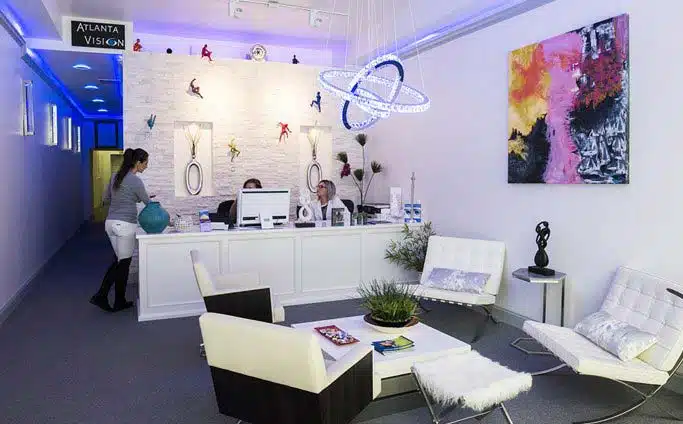Nearsightedness, or myopia, is the most common refractive error, with nearly 42% of the American population experiencing blurry vision when trying to focus on far-away objects. While glasses and contact lenses can offer a temporary solution, they come with their own set of hassles and require constant maintenance, physically and financially.
Today, many people with nearsightedness turn to vision correction surgeries to permanently improve their vision and eliminate their need for visual aids. Depending on the patient, several surgery options are available, and a number of factors affect their cost.
Keep reading to learn more about surgeries that can fix nearsightedness and the factors that can affect cost.
What Causes Nearsightedness?
Nearsightedness occurs when the eye is too long or misshapen, causing light to focus in front of the retina instead of directly on the center. This refractive error results in clear close vision but blurry distance vision.
Nearsightedness often begins in childhood and can get progressively worse over time. While children with nearsighted parents are more likely to develop the condition, other factors, like prolonged close-up work (reading or using a computer) or limited outside time, may also contribute to the development of nearsightedness.
What Surgeries Can Fix Nearsightedness?
Depending on your individual vision needs and goals, there are several excellent surgical options to fix nearsightedness. These options include:
LASIK
LASIK (Laser-Assisted In Situ Keratomileusis) is the most widely performed surgery to fix nearsightedness, farsightedness, and astigmatism. It is a quick procedure with short recovery times and impressive outcomes.
LASIK involves creating a thin flap on the cornea, reshaping the underlying tissue, and repositioning the flap. Many patients report noticeably improved vision within a day of the surgery.
Ideal candidates have a stable prescription, sufficient corneal thickness, and no untreated dry eye.
PRK
PRK (Photorefractive Keratectomy) is similar to LASIK, but involves entirely removing the surface of the cornea, the epithelium. It corrects nearsightedness by reshaping corneal tissue.
The recovery times for PRK are typically longer than for LASIK, but the visual results are generally the same. PRK is often a more suitable option for people with thin corneas, which might disqualify them as candidates for LASIK.
It can also be a better option for a person who is very active or plays a contact sport, which can increase the risk of post-LASIK flap complications.
SMILE
SMILE (Small Incision Lenticule Extraction) is a newer LASIK alternative that can correct nearsightedness and astigmatism. During the surgery, a small incision is created at the edge of the cornea.
The incision is used to access the cornea and make a small disk of tissue (lenticule) inside the cornea, which is then removed. SMILE can be a suitable option for patients with thin corneas, concerns about dry eye, or those at higher risk for eye injuries, like athletes.
EVO ICL
The EVO ICL is an implantable collamer lens that corrects nearsightedness and astigmatism like a regular contact lens. However, it is instead implanted between the iris and the natural lens of the eye rather than sitting on top of it.
It is made of a biocompatible material that works seamlessly with the eye. The EVO ICL surgery is minimally invasive, with short recovery times and a low risk of complications.
The EVO ICL is unique among vision correction surgeries in that it is reversible. If you change your mind for any reason, your eye doctor can remove the EVO ICL and restore your vision to how it was before.
It also offers extra UV protection, making it suitable for patients who spend a lot of time outside.
How Much Does Vision Correction Surgery Cost?
The cost of surgeries to correct nearsightedness varies based on several factors. These factors include:
Type of Procedure
Although many variables can affect the total cost of any procedure, some may be less expensive than others. Generally speaking, LASIK and PRK are often the least costly procedures, while newer SMILE and EVO ICL surgeries tend to have a higher price tag.
Technology Used
Surgeries that use the latest bladeless, wavefront-guided, or femtosecond laser technology, like SMILE, often cost more than other surgeries.
Surgeon’s Expertise
Highly experienced and board-certified eye surgeons may charge more for their expertise. A proven track record can often be worth the cost to patients seeking optimal results.
Complexity of Correction
Patients with higher degrees of nearsightedness or an underlying eye condition might expect to pay more for surgery. These patients could require a specialist to safely complete more intricate procedures.
Location
Where a patient lives can affect the cost of surgery to correct nearsightedness. Practices in urban areas or regions of the country with higher costs of living generally charge more for surgeries.
Is It Worth It to Correct My Nearsightedness with Surgery?
While the right treatment for your nearsightedness will ultimately be up to you and your eye doctor, patients who choose vision correction surgery enjoy unique benefits, including:
Freedom From Visual Aids
The majority of patients who undergo vision correction surgery enjoy complete freedom from glasses and contacts for decades. This means no more wiping smudges off your lenses or pushing them up the bridge of your nose, and no more needing to remove and clean your contact lenses every evening.
Crisp, Clear Vision
After vision correction surgery, most patients experience better vision than they ever had before, with enhanced depth perception and better visual acuity during all their favorite activities. This is because your eye is precisely reshaped to correct your specific refractive errors.
Savings on Glasses and Contacts
Vision correction surgery can be an excellent financial investment. While they often have a higher upfront cost, the money you’ll save on the recurring costs of visual aids over time can be more than the cost of the procedure.
There are also financing options available, like CareCredit, that can help you pay for your procedure in installments rather than all at once, so you can easily fit it into your budget!
Are you ready to find out whether a vision correction surgery could be the right treatment for your nearsightedness? The first step is booking a consultation with your ophthalmologist so they can determine your candidacy and recommend the best course of treatment for your unique circumstances.
Schedule your appointment today at Atlanta Vision Institute in Atlanta, GA!

Please Take Our LASIK or Cataract Surgery Quiz
Take our vision quiz to find out if you qualify for LASIK or cataract surgery!





